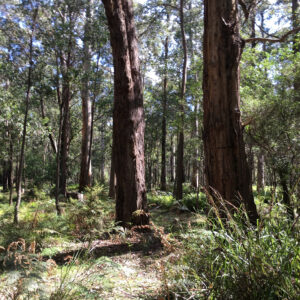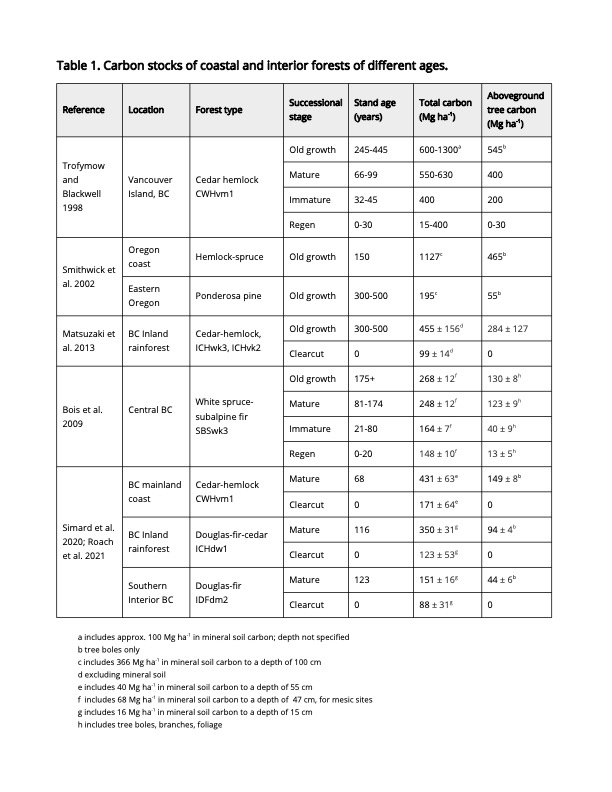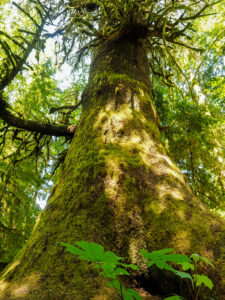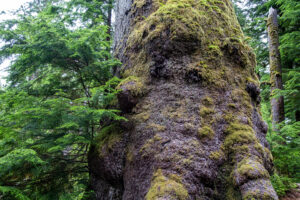Carbon sequestration and storage
Highlights
- BC’s old coastal forests store huge amounts of carbon (up to 1,300 Mg ha-1) which is more than in tropical or boreal areas and second in the world only to old multi-layered Australian temperate moist mountain ash forests.
- On sites like Fairy Creek, old forests are estimated to store twice as much carbon as mature forests and six or more times as much as clearcuts. Productive coastal old forests can store up to six times more carbon than old forests in drier climatic areas.
- As forests age, the rate of net carbon uptake by trees levels off or decreases but they still remove carbon dioxide from the air and total storage continues to increase unless a stand-replacing disturbance occurs.
- Logging old-growth forests releases 40–65% of the ecosystem carbon to the atmosphere, even when off-site storage of carbon in wood products is factored in.
- For a second growth stand to recover the amount of carbon stored in a 300-year-old stand (i.e., to get back to the same carbon density per hectare) could take 200 years or more, therefore crucial short-term greenhouse gas mitigation objectives will not be met by converting old growth to second growth.
- During stand development, part of the carbon sequestered by trees and other vegetation is transferred to the carbon stock of the soil in the form of litterfall and root turnover. Organic matter and carbon steadily accumulate in the forest floor and mineral soil horizons as stand age.
Climate change and greenhouse gases
Carbon sequestration by forests
Release of carbon through respiration and decomposition
Carbon balance in forests
Effect of logging on the carbon balance
Logging old-growth forests and replacing them with vigorous second-growth stands will not improve the forest carbon balance, at least in the short-term. For a second growth stand to recover the amount of carbon stored in a 300-year-old stand (i.e., to get back to the same carbon density per hectare) could take 200 years or more, therefore crucial short-term GHG mitigation objectives will not be met with this replacement strategy (Pojar, 2021Pojar, J. 2021. Old-growth forests of Fairy Creek, Vancouver Island, British Columbia. More).
A large pulse of carbon is lost immediately after clearcut logging due to the removal of all or most trees. Respiration is also increased after logging because disturbance to the soil and original vegetation, and sometimes warming of the site, results in an increased rate of decomposition of coarse woody debris, litter, and soil organic matter. As well, sequestration rates are lower for one to several decades after logging until rates of net carbon uptake in the secondary forest return to pre-harvest rates. The net effect is that losses of carbon dioxide due to respiration exceed the amount fixed through photosynthesis by the regenerating forest for at least a decade (Fredeen et al., 2007Fredeen, A.L., Waughtal, J.D., Pypker, T.G. 2007. When do replanted sub-boreal clearcuts become net sinks for CO2? For. Ecol. Manag. 239:210-216. https://doi.org/10.1016/j.foreco.2006.12.011 More; Luyssaert et al., 2008Luyssaert, S., Schulze, E.-D., Börner, A, Knohl, A., Hessenmöller, D., Law, B.E., Ciais, P., Grace, J. 2008. Old-growth forests as global carbon sinks. Nature 455:213-215. More)
Amount of carbon stored in forests

Influence of climate on carbon stored in forests

Table 1: Carbon stocks of coastal and interior forests of different ages.
Click image to enlarge the table (PDF).



